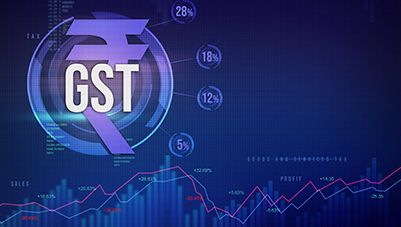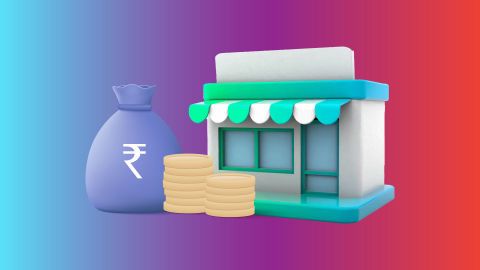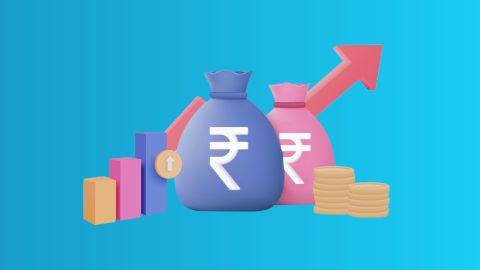India has four types of GST: Integrated Goods and Services Tax (IGST), State Goods and Services Tax (SGST), Central Goods and Services Tax (CGST), and Union Territory Goods and Services Tax (UTGST). This simple division makes it easy to tell the difference between interstate and intrastate goods. It also reduces indirect taxes. Read about these three kinds of GST to find out more.
Types of GST in India
There are 4 GST types in India:
- Integrated Goods and Services Tax (IGST): Levied on inter-state transactions.
- State Goods and Services Tax (SGST): Imposed by state governments on intra-state sales.
- Central Goods and Services Tax (CGST): Collected by the central government on intra-state supplies.
- Union Territory Goods and Services Tax (UTGST): Applicable to transactions in Union Territories.
- GST aims to streamline taxation by replacing multiple indirect taxes with a unified system, promoting ease of compliance and reducing tax cascading.
Components of GST and its explanation
1. State Goods and Services Tax or SGST
- State tax: SGST is levied by state governments on intra-state supplies of goods and services.
- Revenue sharing: Revenue collected under SGST goes directly to the respective state government.
- Part of dual GST: SGST operates alongside Central GST (CGST) in the dual GST structure.
- Compliance: Businesses must comply with SGST provisions and file returns with state tax authorities.
- Input Tax Credit: Input tax credit is available on SGST paid, which can be utilised against SGST liability.
- Rates: SGST rates are uniform across states but can vary by product or service.
2. Central Goods and Services Tax or CGST
- Central tax: CGST is levied by the Central Government on intra-state supplies of goods and services.
- Revenue collection: The revenue collected under CGST goes directly to the Central Government.
- Dual GST structure: CGST works alongside State GST (SGST) for intra-state transactions.
- Input Tax Credit: Businesses can claim input tax credit on CGST paid, which can be set off against CGST or IGST liabilities.
- Compliance: Businesses must comply with CGST provisions and file returns with central tax authorities.
- Uniform rates: CGST rates are standardized across India, varying by product or service category.
3. Integrated Goods and Services Tax or IGST
- Inter-state tax: IGST is levied on inter-state supplies of goods and services, including imports and exports.
- Revenue distribution: The revenue collected under IGST is shared between the Central and State Governments based on the destination state.
- Single tax: IGST replaces separate taxes on inter-state transactions, providing a streamlined tax structure.
- Input Tax Credit: IGST also helps you claim an input tax credit. It is a facility that checks cascading taxes and allows business owners to save at every stage of the supply chain.
- Compliance: Businesses involved in inter-state trade must comply with IGST provisions and file returns accordingly.
Make your supply chain even more efficient. Keep your working capital reserves filled with a collateral-free Bajaj Finserv Business Loan. You can boost your supply chain efficiencies today when you check your pre-approved loan offer.
Additional read: E-Way Bill.
4. Union Territory Goods and Services Tax or UGST
- Union territory tax: UTGST is levied on intra-Union Territory supplies of goods and services, applicable in Union Territories without a legislature.
- Revenue collection: The revenue collected under UTGST goes directly to the Union Territory’s administration.
- Dual GST structure: UTGST is implemented alongside Central GST (CGST) for intra-Union Territory transactions.
- Input Tax Credit: Businesses can claim input tax credit on UTGST paid, which can be used against UTGST liabilities.
- Compliance: Businesses in Union Territories must comply with UGST provisions and file returns with the Union Territory tax authorities.
- Applicable areas: UTGST applies in Union Territories like Chandigarh, Lakshadweep, and Andaman & Nicobar Islands.
Difference between types of GST
Type of GST |
Full Form |
Levied By |
Applicability |
Input Tax Credit (ITC) Availability |
CGST |
Central Goods and Services Tax |
Central Government |
On intra-state supply of goods and services |
ITC can be claimed against CGST and IGST liabilities |
SGST |
State Goods and Services Tax |
State Government |
On intra-state supply of goods and services |
ITC can be claimed against SGST and IGST liabilities |
UTGST |
Union Territory Goods and Services Tax |
Union Territory Administration |
On intra-union territory supply of goods and services |
ITC can be claimed against UTGST and IGST liabilities |
IGST |
Integrated Goods and Services Tax |
Central Government |
On inter-state supply of goods and services, and imports |
ITC can be claimed against IGST, CGST, and SGST/UTGST liabilities |
Taxes replaced by GST
GST was implemented with the aim of achieving “One Nation, One Tax” to simplify the complexities of multiple registrations for various indirect taxes. As a result, GST consolidated several Central and State indirect taxes, including:
Central Taxes |
State Taxes |
● Central excise duty |
● Purchase tax |
● Central sales tax |
● Entry Tax |
● Service tax |
● VAT |
● Additional duties of customs |
● Surcharge and Cess |
● Additional duties of excise |
● Taxes on lottery, gambling and betting |
● Excise duty levied under the textile products |
● Taxes on advertisements |
|
● Luxury Tax |
|
● Entertainment Tax |
Types of GST
The main types of GST are determined based on the nature of the transaction, and include:
- Inter-state transactions: These transactions occur between two different states, where the GST is allocated between the Central government and the state where the goods are consumed or the service is utilised.
- Intra-state transactions: A transaction that takes place within the same state is referred to as an intra-state transaction. In this case, the GST is shared between the Central government and the state where the transaction occurs.
Application of different types of GST
Scenario |
GST Rate |
GST Calculation |
Total Amount |
SGST |
CGST |
IGST |
Distribution |
A vendor in Karnataka sells goods worth Rs. 30,000 to a customer in Karnataka |
12% |
12% of Rs. 30,000 = Rs. 3,600 |
Rs. 33,600 |
Rs. 1,800 |
Rs. 1,800 |
- |
Rs. 1,800 SGST is received by the Karnataka Government. Rs. 1,800 CGST is received by the Central Government. |
A vendor in Karnataka sells goods worth Rs. 30,000 to a customer in Gujarat |
12% |
12% of Rs. 30,000 = Rs. 3,600 |
Rs. 33,600 |
- |
- |
Rs. 3,600 |
Rs. 3,600 IGST is received by the Central Government. |
A supplier in Gujarat sells goods worth Rs. 25,000 to a buyer in Maharashtra |
18% |
18% of Rs. 25,000 = Rs. 4,500 |
Rs. 29,500 |
- |
- |
Rs. 4,500 |
Rs. 4,500 IGST is received by the Central Government. |
Who is liable to pay GST?
The following categories of individuals are responsible for paying GST:
- Individuals registered under GST and engaged in making taxable supplies.
- GST-registered persons who are required to pay under the reverse charge mechanism.
- Persons registered under GST and obligated to deduct tax at source (TDS).
- E-commerce operators registered under GST.
- E-commerce operators registered under GST and required to collect tax at source (TCS).
- Individuals supplying goods or services on behalf of a supplier or manufacturer (agents).








 Food & Beverages
Food & Beverages Fashion
Fashion Beauty & Personal Care
Beauty & Personal Care Health & Wellness
Health & Wellness Home & Kitchen
Home & Kitchen

 Loan Against Shares
Loan Against Shares Loan Against Mutual Funds
Loan Against Mutual Funds Loan Against Bonds
Loan Against Bonds Loan Against Insurance Policy
Loan Against Insurance Policy ESOP Financing
ESOP Financing Two-wheeler Loan
Two-wheeler Loan Loan for Lawyer
Loan for Lawyer Industrial Equipment Finance
Industrial Equipment Finance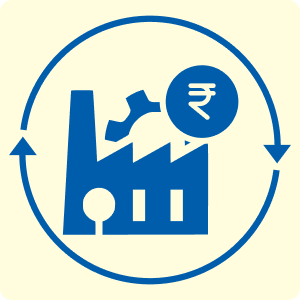 Industrial Equipment Balance Transfer
Industrial Equipment Balance Transfer Industrial Equipment Refinance
Industrial Equipment Refinance
 Smartphones
Smartphones Air Conditioner
Air Conditioner Led TVs
Led TVs Air Coolers
Air Coolers Refrigerators
Refrigerators Washing Machines
Washing Machines Laptops
Laptops

 Trading Account
Trading Account Open Demat Account
Open Demat Account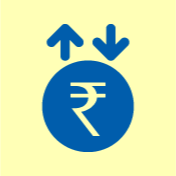 Margin Trading Financing
Margin Trading Financing Share Market
Share Market Invest in IPO
Invest in IPO All stocks
All stocks Top gainers
Top gainers Top losers
Top losers 52 week high
52 week high 52 week low
52 week low
 Business Loan
Business Loan Secured Business Loan
Secured Business Loan Loan against property
Loan against property Loans against property balance transfer
Loans against property balance transfer Loan against shares
Loan against shares Home Loan
Home Loan Loans against mutual funds
Loans against mutual funds Loan against bonds
Loan against bonds Loan against insurance policy
Loan against insurance policy
 Term Life Insurance
Term Life Insurance ULIP Plan
ULIP Plan Savings Plan
Savings Plan Retirement Plans
Retirement Plans Child Plans
Child Plans Investment Plans
Investment Plans
 Get Bajaj Prime
Get Bajaj Prime
 ULIP Plan
ULIP Plan Savings Plan
Savings Plan Retirement Plans
Retirement Plans Child Plans
Child Plans Free Demat Account
Free Demat Account Invest in IPO
Invest in IPO Invest in Stocks
Invest in Stocks Margin Trading Facility
Margin Trading Facility
 Check your Credit Score
Check your Credit Score
 Bike
Bike Scooter
Scooter Electric Vehicle
Electric Vehicle Best Sellers
Best Sellers Popular Brands
Popular Brands
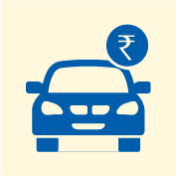 New Car Loan
New Car Loan Used Car Loan
Used Car Loan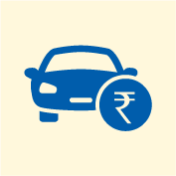 Loan Against Car
Loan Against Car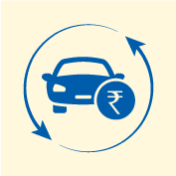 Car Loan Balance Transfer and Top-up
Car Loan Balance Transfer and Top-up
 Engagement Zone
Engagement Zone Game Zone
Game Zone
 Personal Loan EMI Calculator
Personal Loan EMI Calculator Personal Loan Eligibility Calculator
Personal Loan Eligibility Calculator Home Loan EMI Calculator
Home Loan EMI Calculator Home Loan Eligibility Calculator
Home Loan Eligibility Calculator Good & Service Tax (GST) Calculator
Good & Service Tax (GST) Calculator Flexi Day Wise Interest Calculator
Flexi Day Wise Interest Calculator Flexi Transaction Calculator
Flexi Transaction Calculator Secured Business Loan Eligibility Calculator
Secured Business Loan Eligibility Calculator Fixed Deposits Interest Calculator
Fixed Deposits Interest Calculator Two wheeler Loan EMI Calculator
Two wheeler Loan EMI Calculator New Car Loan EMI Calculator
New Car Loan EMI Calculator Used Car Loan EMI Calculator
Used Car Loan EMI Calculator All Calculator
All Calculator
 Hot Deals
Hot Deals Clearance Sale
Clearance Sale Kitchen Appliances
Kitchen Appliances Tyres
Tyres Camera & Accessories
Camera & Accessories Mattresses
Mattresses Furniture
Furniture Watches
Watches Music & Audio
Music & Audio Cycles
Cycles Mixer & Grinder
Mixer & Grinder Luggage & Travel
Luggage & Travel Fitness Equipment
Fitness Equipment Fans
Fans
 Personal Loan for Doctors
Personal Loan for Doctors Business loan for Doctors
Business loan for Doctors Medical Equipment Finance
Medical Equipment Finance Secured Business Loan
Secured Business Loan Loan against property
Loan against property Loan against share
Loan against share Gold Loan
Gold Loan Home Loan
Home Loan
 Smartphones
Smartphones Air Conditioners
Air Conditioners LED TVs
LED TVs Air Coolers
Air Coolers Refrigerators
Refrigerators Washing Machines
Washing Machines Laptops
Laptops Water Purifiers
Water Purifiers Tablets
Tablets Kitchen Appliances
Kitchen Appliances Mattresses
Mattresses Furniture
Furniture Music and Audio
Music and Audio Cameras & Accessories
Cameras & Accessories Cycle
Cycle Watches
Watches Tyres
Tyres Luggage & Travel
Luggage & Travel Fitness Equipment
Fitness Equipment
 Home Loan
Home Loan Transfer your existing Home loan
Transfer your existing Home loan Loan against Property
Loan against Property Home Loan for Salaried
Home Loan for Salaried Home loan for self employed
Home loan for self employed Home Loan EMI Calculator
Home Loan EMI Calculator Home Loan eligibility calculator
Home Loan eligibility calculator Home Loan balance transfer
Home Loan balance transfer
 Offer World
Offer World
 Articles
Articles
 Overdue Payments
Overdue Payments Other Payments
Other Payments
 Document Center
Document Center Bank details & Documents
Bank details & Documents Tax Invoice Certificate
Tax Invoice Certificate
 Do Not Call Service
Do Not Call Service
 Your Orders
Your Orders Hamara Mall Orders
Hamara Mall Orders

 Fixed Deposit (IFA) Partner
Fixed Deposit (IFA) Partner Loan (DSA) Partner
Loan (DSA) Partner Debt Management Partner
Debt Management Partner EMI Network Partner
EMI Network Partner Become a Merchant
Become a Merchant Partner Sign-in
Partner Sign-in
 Food & Shopping
Food & Shopping Credit Card Hub
Credit Card Hub ULIP Plans
ULIP Plans Top Gainers Stock
Top Gainers Stock Top Losers Stock
Top Losers Stock Saving Plan
Saving Plan Term Insurance
Term Insurance
 Live Videos
Live Videos
















